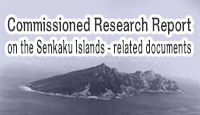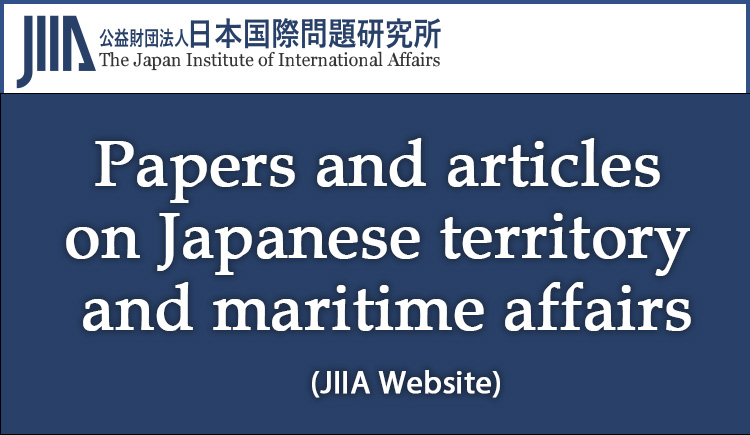The documents and materials published on this website were collected, researched, and prepared with advice from experts, as a part of a Government-commissioned project. The contents of this website do not reflect the views of the Government.
Comprehensive issues
Column Function of Maps in Territorial Disputes ― Treatment of Maps by International Tribunals ―
Tetsuya NAKANO (Kansai University)
*Adobe Acrobat Reader DC, provided by Adobe, is needed to view the PDF files. If you do not have the software, please download it from the linked site. Adobe Acrobat Reader DC
1. Territorial Disputes and Standards of Dispute Settlement
State territory consists of land, waters, and airspace which is subjected to the sovereignty of the State. Rights regarding territory, including the right to govern and the right to dispose of territory, are referred to as territorial sovereignty.
Japan holds the position that there exists a “dispute over territorial sovereignty over Takeshima” between itself and the Republic of Korea.1 “Dispute over territorial sovereignty,” in light of the above, means one which arises when the States concerned do not agree on the extent to which they can exercise territorial sovereignty.
International law has dealt with such disputes mainly through rules related to title to territory. Title to territory provides the cause or factual basis for effective exercise of territorial sovereignty over a certain area of land. Traditionally, original or historic title, occupation, prescription, cession, annexation, accretion, and subjugation have been recognized as the modes of acquisition of title to territory. However, the traditional mode of title to territory is “a system in which title and title-holder establish a single title to the territory in question.”2 It is not a standard of dispute settlement designed for cases like the Takeshima dispute where more than one State claim title to the same territory.3 Furthermore, territorial disputes often emerge due to the complexity and diversity of the facts. For example, when occupation is claimed, it is extremely difficult to find the facts necessary for determining whether the area in question was terra nullius or territory of another State and which State had taken effective control over it.4
International tribunals to which territorial disputes have been referred have thus presented their own standards for dealing with disputes.5 The earliest example is the title of “continuous and peaceful display of territorial sovereignty” put forward by the sole arbitrator in the Island of Palmas case in 1928.6 On the other hand, in the Minquiers and Ecrehos case, the International Court of Justice (ICJ) considered the attribution of the disputed islets in light of evidence directly related to occupation of the islets,7 i.e., evidence corresponding to “[exercise of] State functions” and “intention of that Government to act as sovereign.”8
Note1
Note2
Huh Sookyeon, “Ryoikiken Genron Saiko (1)” [Reconsidering the Theory of Territorial Title (1)], Kokka Gakkai Zassi [The Journal of the Association of Political and Social Sciences], Vol. 122, No. 1-2, p. 36.
Note3
Masaharu YANAGIHARA, Kokusaiho [International Law], Tokyo: Foundation for the Promotion of the Open University of Japan, 2014, p. 106; Hironobu SAKAI, “Kokusai Saiban ni yoru Ryoiki Funso no Kaiketsu” [Settlement of Territorial Disputes by International Tribunals], Kokusai Mondai [International Affairs], No. 624 (September 2013), p. 11; Huh Sookyeon, “Ryodo Kizoku Hori no Kozo: Kengen to effectivité wo meguru Gokai mo Fukumete” [Structure of the Territorial Attribution Doctrine: Including Misunderstandings About Title and Effectivité], Kokusai Mondai [International Affairs], No. 624 (September 2013), p. 23; Kyoko HAMAKAWA, “Senkaku Shoto no Ryoyu wo meguru Ronten” [Issues Surrounding Possession of the Senkaku Islands], Chosa to Joho [Issue Brief], No. 565, p. 2.
Note4
YANAGIHARA, supra note 3, Kokusaiho, p. 106; Kanae TAIJUDO, “Takeshima Funso” [Takeshima Dispute], in ibid, Ryodo Kizoku no Kokusaiho [The International Law of Territorial Attribution], Tokyo: Toshindo, 1998, pp. 139-140.
Note5
Giovanni Distefano, “The Conceptualization (Construction) of Territorial Title in the Light of the International Court of Justice Case Law,” Leiden J.I.L., Vol. 19 (2006), p. 1048.
Note6
Island of Palmas Case (Netherlands/United States of America), Award of 4 April 1928, RIAA, Vol. II (1949), p. 839.
Note7
The Minquiers and Ecrehos Case, Judgment of November 17th, 1953: I.C.J. Reports 1953, p. 57.
Note8
Ibid., pp. 60-72.
2. Function of Maps
(1)Overview
States faced with territorial disputes regard maps as a piece of evidence that directly or indirectly establishes “continuous and peaceful display of territorial sovereignty,” “exercise of State functions,” or “intention of that Government to act as sovereign,” and have striven to collect such maps. Hence, parties submit various types of maps if territorial disputes are referred to international tribunals.
That said, international tribunals have held that, in determining the existence of titles, including “continuous and peaceful display of territorial sovereignty,” maps can be direct evidence of the existence of such a title only if they are annexed to an official text such as a treaty determining the attribution of territory of which they form an integral part. Such maps are incorporated into text that expresses the will of the States concerned,9 and therefore, can be considered to have the same effect as the text and an integral part of it.10
Except in these very limited cases, as a general rule, a title to territory will never be established by a map alone or by the mere fact that a map exists. Maps are confined to secondary evidence that endorses a conclusion reached by means unconnected with the maps, and will not be regarded as decisive evidence that can constitute a title to territory.11 Their value as secondary evidence also varies depending on a number of factors, including their source, consistency, the response of the parties to the dispute, and when the maps were created.
(2)Factors influencing the evidentiary value of maps
i. Source
Official maps produced and published by State agencies and semi-official maps produced and published under the auspices of or with the official permission of State agencies have been estimated as having relatively high evidentiary value, because they can be considered to have been produced on the basis of carefully collected information. For example, the award in the Island of Palmas case suggests that the relevant maps have high evidentiary value.12 The judgment in the Clipperton Island case did not give importance to the map used by Mexico for the reason that “the official character of this map cannot be affirmed.”13
However, even official maps are not necessarily absolutely reliable or objectively accurate.14 In particular, if a party to the dispute produce “official” or “semi-official” maps of the disputed territory after the dispute arose, such maps will have lower evidentiary value compared to maps produced before the dispute arose. This is because maps produced after the dispute arose are unlikely to contain information unfavorable to the party.15 It is for the same reason that maps produced not by a party to the dispute but by a neutral organization are deemed to have evidentiary value. Such maps are considered to contain objective information that can be relied upon since the organizations have no conflict of interest with the parties to the dispute.16
Private maps produced by private individuals have little evidentiary value and are often not subject to examination, except in cases where they are considered to have particularly high reliability due to the reputation of the cartographer, such as a renowned expert in the field.17
Maps of an unknown source have less evidentiary value if there exist legally relevant facts which contradict the information they show, “however numerous and generally appreciated they may be.”18
Note9
Diffërend frontalier, arrêt, C.I.J. Recueil 1986, p. 582, par. 54. See also, Decision regarding delimitation of the border between Eritrea and Ethiopia (hereinafter referred to as Eritrea and Ethiopia case), Reports of International Arbitral Awards, Vol. XXV, pp. 113-114, paras. 3.18, 3.20.
Note10
See also, Marcelo G. Kohen and Mamadou Hébié, “Territory, Acquisition,” in Rüdiger Wolfrum (ed.), The Max Planck Encyclopedia of Public International Law, Vol. IX, Oxford, New York: Oxford University Press, 2012, pp. 888-889, para. 3.
Note11
Diffërend frontalier, arrêt, supra note 9, pp. 582-583, pars. 54, 56. Tomoko FUKAMACHI, “Ryodo Kizoku Handan ni okeru Kanren Yoso no Koryo” [Consideration of Relevant Factors for Determination of Territorial Attribution], Kokusai Mondai [International Affairs], No. 624 (September 2013), pp. 40-41; Norio ARAKI, “Ryodo Kokkyo Funso ni okeru Chizu no Kino” [Function of Maps in Territorial and Border Disputes], Waseda Hogaku [Waseda Law Review], Vol74, No. 3 (1999), pp. 23-24; Victor Prescott and Gillian D. Triggs, International Frontiers and Boundaries: Law, Politics and Geography, Leiden: Martinus Nijhoff, 2008, p. 192.
Note12
Island of Palmas Case, supra note 6, pp. 852, 854, 861-862.
Note13
Clipperton Island Case (1931), RIAA, Vol.II, p. 1105.
Note14
Dispute between Argentina and Chile concerning the Beagle Channel (hereinafter referred to as Beagle Channel Case), RIAA, Vol. XXI, pp. 164-165, para. 138.
Note15
ARAKI, supra note 11, p. 9.
Note16
Diffërend frontalier, supra note 9, p. 583, para. 56.
Note17
Beagle Channel Case, pp. 171-172, paras. 148-149.
Note18
Island of Palmas Case, supra note 6, p. 853.
Senkaku Islands
Research and Commentary Site
- I Comprehensive issues
- II Commentary on themes by historical period
- III Analysis of claims by other countries





